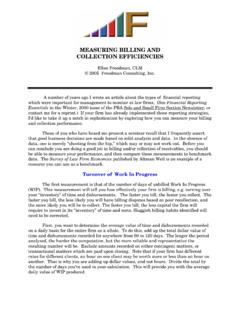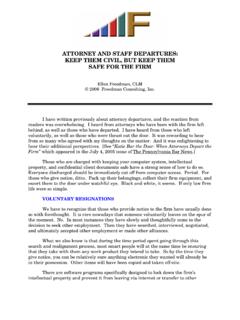Transcription of HOW MANY NON-LAWYERS DOES IT TAKE TO …
1 HOW many NON-LAWYERS does IT take TO RUN A LAW FIRM? Ellen Freedman, CLM 2005 Freedman Consulting, Inc. From an attorney s perspective, there are only two types of employees in a law firm: lawyers and NON-LAWYERS . Unlike other business entities, the law firm has a uniquely horizontal pecking order, at least at first blush. Small wonder, then, that many attorneys are frequently confused as to the proper staff person to approach for a particular task, and others almost never get a staff person s title correct when referring to or introducing him or her. A ROSE BY ANY OTHER NAME The purpose of this article is to identify the key staff positions and their related responsibilities. Keep in mind that there are exceptions to every rule. many times attorneys consider a better title a cheaper consideration than a raise. For example, one can find Executive Directors in small firms, but on examination their duties will fall in line with those of Office Managers or Administrators, which are the more appropriately used titles of their peers in similarly sized firms.
2 Administrators and Office Managers also use titles creatively to attract and retain staff beneath them. Thus the ever-growing confusion regarding the titles of secretary, legal assistant, and paralegal, as they are inconsistently applied from firm to firm. Another reason why exceptions exist is that despite their similarities, each law firm is a unique living breathing entity. Therefore, the job duties of Executive Directors at two identically sized firms may vary in meaningful ways. Those variations are driven by the desires and needs of each firm. And finally, the size of the firm, and to a certain extent it s sophistication in terms of management, will determine the type of person needed at the top of the staff pyramid , and so forth down the line. A sophisticated 15-attorney firm will likely have an Administrator. A less sophisticated firm of the same size will likely have an Office Manager.
3 The level at which they operate will be different, with the latter being less involved with the management committee, less involved in strategic planning, and totally immersed in the day-to-day hands-on operation of the firm. HOW many NON-LAWYERS does IT take TO RUN A LAW FIRM? Page 2 of 6 Freedman Consulting, Inc. (215) 628-9422 ADMINISTRATION At the top of the non-lawyer pyramid in a mid to large-size firm is a manager with a title such as Chief Operations Officer, Executive Director, Director of Administration, or Administrator. No matter what the title, this individual is the principal administrator who reports directly to the managing partner/management and/or executive committee; assists in developing organizational and business goals; participates in meetings of the firm s governing body; participates in developing strategic plans and administrative policies; and directs a supervisory staff responsible for carrying out the firm s day-to-day operations.
4 The larger the firm, the more likely that there will be a hierarchy of top management. For example, there may be an Executive Director as well as an Administrator, and possibly even Office Managers in branch offices. In the mid-size firm environment, the Administrator is responsible for the day-to-day operations of all or most support functions. This is a much more hands on position than that of Executive Director. Often the Administrator operates in a firm not quite large enough to justify employing mid-level managers, and so must master the hands-on management of the key skill areas in the firm, technology, financial management, human resources and so forth. When the firm grows a little larger and starts to need and hire mid-level managers, such as a network administrator, controller, etc., the firm s top manager becomes the Director of Administration. At this level there is more involvement in strategic planning and consistent contact with the management committee, and different people management skills come into play to manage and guide those who directly supervise others and carry out the day-to-day operations.
5 Generally speaking, the emphasis of the Director of Administration s duties centers on planning and implementation and working directly for/with the managing body of the firm, as opposed to being directly involved, in other than a supervisory capacity, in the day-to-day operations of the firm. This position usually carries a good deal of authority to execute the responsibilities assigned by firm management. For small and mid-size firms the Office Manager operates specifically in the day-to-day operations of the firm, and normally doesn t participate in setting policy or strategic planning. The Office Manager reports to the Administrator or Director of Administration in larger firms. The Office Manager will have limited areas of responsibility in larger firms, and more encompassing responsibilities in smaller firms. Usually the Office Manager is granted only limited authority to back up the responsibilities assigned.
6 OPERATIONS / FACILITIES The Office Services Manager, also called the Facilities Manager, reports directly to the Administrator, and supervises the messengers, receptionists, supply clerks, file clerks, copy machine operators, courthouse runners, housekeeping staff, and so forth. HOW many NON-LAWYERS does IT take TO RUN A LAW FIRM? Page 3 of 6 Freedman Consulting, Inc. (215) 628-9422 This person is usually responsible for file room maintenance, closed file storage and retrieval, simple office repairs, stocking and fixing of fax and copy machines, and internal moves from office to office. This is the person who produces the trial bag, easel and white board, and arranges for delivery of your 15 banker s boxes to court on short notice. If there s only one staff person in the office with whom you will become familiar and maintain the best rapport, this is the one!
7 The Human Resources Manager has overall responsibility for all personnel matters regarding support staff, which may include hiring, assignments, supervision, orientation and training, evaluation, personnel records, and salary and benefits administration. The reason the duties MAY include certain aspects is that some Administrators elect to retain hands-on control of certain very sensitive aspects, such as hiring and/or compensation plan administration. In larger firms there may be a further division of labor within human resources, with the Manager overseeing one or more of the following: a Benefits Coordinator , who is responsible for the day-to-day administration of the various benefit plans; a Staff Recruiter, whose purpose is to continually seek out and hire new staff; and a Payroll Specialist, who accounts for the firm s time off program of sick, personal and vacation days and coordinates that with salary increases and overtime pay to ensure each payroll is correct.
8 In an extremely large firm there may be an additional need for a Retirement Plan Administrator, who handles open enrollments, loans, distributions, changes to deferrals, and coordinates everything with the Payroll Department or Specialist. MARKETING Marketing is another management area which can be simple or complex, depending on the firm and its size. A Marketing Coordinator is responsible for implementing the various individual, departmental and firm-wide marketing plans, projects and strategies. At a larger and/or more sophisticated firm, there may be other individuals as well. For example, there may be need for a Marketing Director or Marketing Manager who has the overall responsibility for development of the marketing program and related activities such as budgeting, idea generation, database maintenance, and supervision of marketing staff. Really large firms also employ individuals such as an Event Coordinator, who plans and manages client parties, fundraisers, client seminars and so forth, and a Database Manager, whose function is to maintain the mailing lists of clients, prospects, and referral sources.
9 INFORMATION TECHNOLOGY A small firm may depend on the Administrator or Office Manager, in conjunction with outside consultants, to plan for and manage all technology. Due to the complexity of today s networks, a firm of as few as 20 users can require a full time Network Administrator, who is responsible for all aspects of running the firm s local or wide area network, and usually any telephone and voice-mail system, too. That responsibility HOW many NON-LAWYERS does IT take TO RUN A LAW FIRM? Page 4 of 6 Freedman Consulting, Inc. (215) 628-9422 includes the daily care and feeding of all computers and devices, and telephone lines and modems. For a firm making heavy use of its technology, there will be another IT person needed for approximately each additional 25 users. For a firm making average use of technology, there can be as many as 40-50 users per IT employee.
10 As a firm s IT department grows, there will come the addition of a Computer Systems Manager, who will oversee the Network Administrator, and also work directly with the firm s Administrator to help develop a technology plan, develop a budget, review new products and software, develop training systems, and provide information used in other areas of the firm. With additional growth and complexity in the firm s technology and overall firm size, may come the addition of a Director of Information Technology, sometimes now referred to as a Chief Information Officer. Although this senior-level position has overall responsibility for planning, managing, and directing technology and communications systems of the organization, it primarily focuses on knowledge management, that is, the development of the governance and organizational structure necessary to nurture the people and systems that create, preserve, disseminate, protect, renew and deploy knowledge, and leverage it to the benefit of the firm and the firm s clients.












